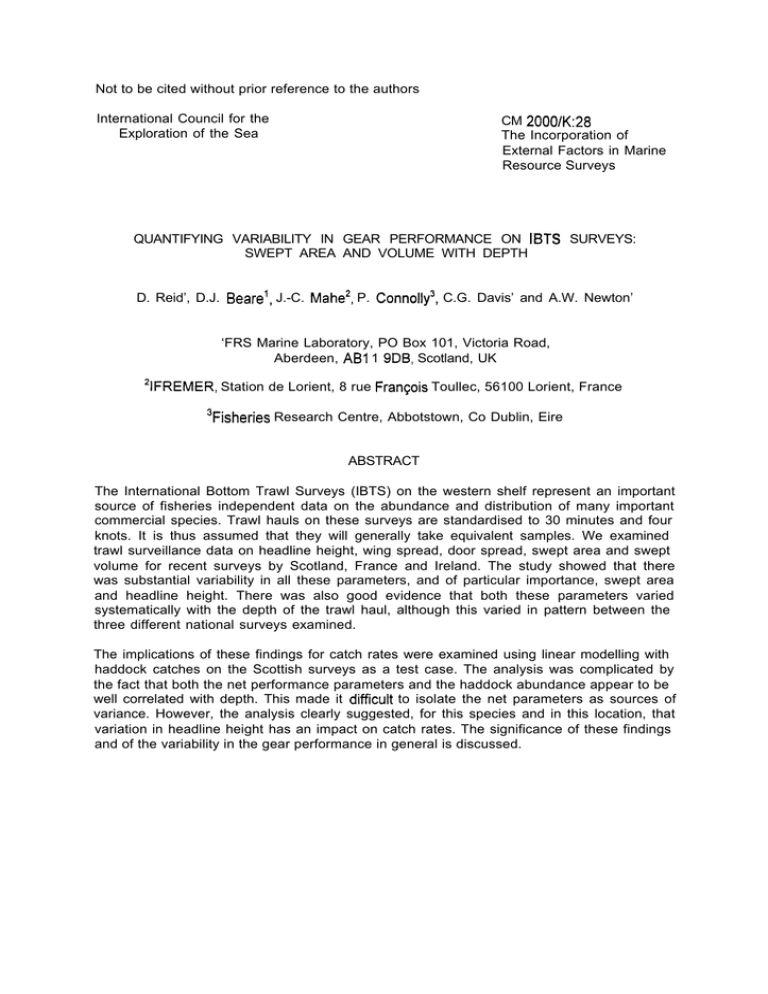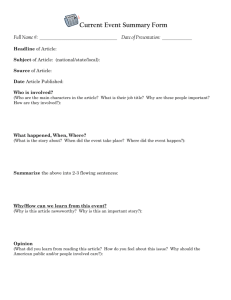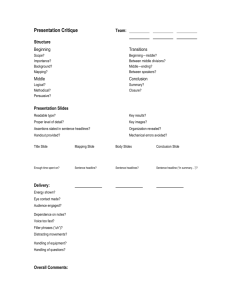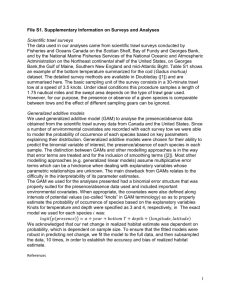Not to be cited without prior reference to the authors
advertisement

Not to be cited without prior reference to the authors International Council for the Exploration of the Sea CM 2000/K:28 The Incorporation of External Factors in Marine Resource Surveys QUANTIFYING VARIABILITY IN GEAR PERFORMANCE ON IBTS SURVEYS: SWEPT AREA AND VOLUME WITH DEPTH D. Reid’, D.J. Beare’, J.-C. Mahe*, P. Connolly3, C.G. Davis’ and A.W. Newton’ ‘FRS Marine Laboratory, PO Box 101, Victoria Road, Aberdeen, ABI 1 9DB, Scotland, UK *lFREMER, Station de Lorient, 8 rue Francois Toullec, 56100 Lorient, France 3Fisheries Research Centre, Abbotstown, Co Dublin, Eire ABSTRACT The International Bottom Trawl Surveys (IBTS) on the western shelf represent an important source of fisheries independent data on the abundance and distribution of many important commercial species. Trawl hauls on these surveys are standardised to 30 minutes and four knots. It is thus assumed that they will generally take equivalent samples. We examined trawl surveillance data on headline height, wing spread, door spread, swept area and swept volume for recent surveys by Scotland, France and Ireland. The study showed that there was substantial variability in all these parameters, and of particular importance, swept area and headline height. There was also good evidence that both these parameters varied systematically with the depth of the trawl haul, although this varied in pattern between the three different national surveys examined. The implications of these findings for catch rates were examined using linear modelling with haddock catches on the Scottish surveys as a test case. The analysis was complicated by the fact that both the net performance parameters and the haddock abundance appear to be well correlated with depth. This made it difficult to isolate the net parameters as sources of variance. However, the analysis clearly suggested, for this species and in this location, that variation in headline height has an impact on catch rates. The significance of these findings and of the variability in the gear performance in general is discussed. INTRODUCTION The major fishery independent tool for assessing demersal fish stocks is the stratified random bottom trawl survey (Pennington and Brown, 1981). Such surveys are particularly important in the North Sea and adjacent areas where a series of international collaborative surveys (IBTS - ICES coordinated International Bottom Trawl Surveys) have been carried over many years (Heessen et al., 1997). Considerable efforts are made to ensure that these surveys are carried out in a standard and consistent way. A manual has been produced describing the construction of the standard net (the GOV - Grande Ouverture Vertical), and standard rigging, deployment and data collection protocols are produced as an IBTS manual (Anon, 1996). When new vessels are introduced into the survey, inter-calibration exercises are carried out (Pelletier, 1998; Zuur and Fryer, 2000). Notwithstanding these efforts, it is still necessary to make some assumptions about the way the gear actually performs. One such assumption is that the standard trawl, towed at a standard speed for a set period will sweep a fixed area of seabed (Forrest and Minnet, 1981). However, this assumption does not necessarily hold true. It is known that swept area increases with depth as a result of the greater length of warp (Carrothers, 1981; God0 and Engas, 1989; Engas, 1994; Rose and Nunnallee, 1997). Goda and Engas (1989) suggested that this might well affect the efficiency of the gear. God0 and Eng&s showed that the increase in swept area was due to an.increase in the spread of the wings and doors. As a corollary to this, the height of the headline reduced with depth, so effectively the net becomes wider and shallower with depth. It is reasonable to assume that either or both these factors (swept area or headline height) are likely to have an impact on the amounts of fish caught. Increase in swept area is likely to result in more fish captured. Decrease in headline height may reduce the amount captured, in that more may be lost over the headline. God@ and Engas (1989) examined trawl surveys in the Svalbard area off Spitsbergen, where depths varied between 20 and 600 m. In the North Sea and adjacent waters, the surveys are usually restricted to 200 m, although in the shelf area to the west of Europe, surveys go down to 500 m. As part of an EU funded project (IPROSTS Study Contract), we set out to determine the variability in trawl performance with depth on a number of IBTS surveys carried out on the west coast of Scotland. In addition, we examined whether there was any evidence from these surveys that any swept area differences found might have an impact on catch rate of two common fish species: haddock (Melanogramus aeglefinus) and whiting (Merlangius merlangus). MATERIALS The Surveys Scotland Trawl data from two Scottish west coast IBTS surveys were used in this analysis (November 1998 and 1999 carried out from FRV Scotia). These surveys were initially selected as they fell within the western area remit of IPROSTS. These surveys use the same, rectangle stratified, sampling design as the North Sea IBTS, but due to the nature of the western Scottish shelf, they tend to cover a wider depth range. Additionally, a recent proposal to harmonise these surveys with those further south would require the depth limit to be extended to 500 m, where the impact of gear performance changes may be even more important. 2 The trawl used was a standard GOV fitted with a heavy ground gear (ground gear C) to cope with the more difficult seabed found in this area. The trawl was fitted with ScanMar sensors to provide headline height (HH), wing spread (WS) and door spread (DS). The sensors were interfaced to a PC for data logging using in-house software. For each haul, the software provides mean HH, WS and DS as well as mean swept areas between the wing ends (Net Swept Area - NSA) and the doors (Gear Swept Area - GSA). NSA and GSA were integrated from recordings of distance traveled and WS/DS every 30 seconds through the operation. Recordings were not started until the gear had settled and was fishing correctly, and were stopped as soon as the gear began to be recovered. The surveys used the current standard 30-minute tow, with the vessel speed maintained at four knots. The surveillance data from 107 valid fishing operations were collected for the analysis. In approximately 5% of operations, the sensor data were corrupted or incorrect and these tows were discarded. France Trawl surveillance and catch data were available from the EVHOE 1999 survey by IFREMER on FRV Thallasa, carried out in the Bay of Biscay and Celtic Sea in November 1999. The survey design used a depth stratified approach, although the stations were ,carried out as standard IBTS half-hour tows. The trawl used was a standard GOV, although headline floats were substituted for the standard kite. Two different sweep lengths were used; 60 m from 0 to 125 m depth and 110 m thereafter. The trawl was fitted with ScanMar sensors to provide headline height (HH), wing spread (WS) and door spread (DS). Swept areas were calculated from these data and from the distance towed. The surveillance data from 105 valid fishing operations were collected for the analysis Ireland Trawl surveillance and catch data were available from the Irish Sea and Celtic Sea Ground Fish Survey (ISCSGFS) carried out by the Marine Institute, Abbotstown on FRV Celtic Voyager, in November 1999. The survey design used a rectangle-stratified approach and the stations were carried out as standard IBTS half-hour tows. The trawl used was a modified (reduced horsepower) GOV. One sweep length of 50 m was used. The trawl was fitted with ScanMar sensors to provide headline height (HH) and door spread (DS). Swept area was calculated from these data and from the distance towed. The surveillance data from 53 valid fishing operations were collected for the analysis. METHODS AND RESULTS Depth Dependence In Trawl Performance Parameters Scotland The basic trawl performance data for the two Scottish surveys are presented against water depth in Figures la to f. Calculated Regressions, R2 values, values at 25 and 200 m and differences are given in Table 1. Figure la shows the change in headline height. There is a clear decrease in this factor with water depth. The calculated headline height goes from 5 m to 3.6 m, a percentage change of 39.7%. Figures 1 b and 1 c show the change in wing and door spread with depth. Again, 3 there are clear changes with depth, particularly in the case of wing spread. Figure Id shows the variability in the distance towed. Most tows are between 1.8 and 2 nmi, a variation of around 10%. These data are also used to generate the swept area values, which are shown for the net - calculated using wing spread, and for the whole gear - calculated using door spread in Figures le and If respectively. In all cases, there are obvious and substantial changes in gear performance with depth. France The French survey uses a similar GOV gear to the Scottish surveys but with differences in rigging described above. The main trawl performance data for the French survey are presented in Figure 2, and the details summarised in Table 2. Using the short sweeps, the French net showed very similar patterns to the Scottish net. The calculated headline height varied from about 4.5 to 3.5 m over 100 m depth range. Wing spread, door spread and net swept area all varied in a similar fashion to that seen on the Scottish surveys. However, with the long sweeps, there was very little change at all with depth. Ireland The Irish survey uses a scaled down version of the GOV suitable to a smaller vessel. The main trawl performance data for the Irish survey are presented in Figures 12 to 15, and the details are summarised in Table 3. No wing spread data and, hence, net swept area, information were available for this survey. The depth range in this survey was also less (maximum depth of 120 m) than the other two surveys. The important points to note are that there was very little variation in the headline height across the depth range, but that door spread varied by around 35%. Analysis of Catch Rates in Relation to Trawl Performance It was clear from the above that there were substantial changes in the performance of the gear across the normal depth range of the surveys. The next question was whether this could be shown to have had any impact on the trawl results. We decided to concentrate on the two most abundant species encountered, haddock and whiting. For this analysis, we used only numbers caught irrespective of age or length. Firstly, haddock and whiting abundance data were log-transformed to normalise the error structure. Histograms and qq-plots confirmed there was acceptable symmetry in the log abundances. The second step was to investigate whether there might be important variations between the two survey years. Haddock and whiting abundance were plotted against six variables (time of day, bottom depth, headline height, net swept area, gear swept area and net swept volume). See Figures 4 and 5. Haddock: 1998 Survey v 1999 Survey Haddock abundance was higher in 1999 than 1998 (Fig. 4). The range of some gear parameters, eg, headline height and gear swept area, were very different between the two surveys. In 1999, headline heights ranged between 4-5.5 m, whereas in 1998 they ranged between 3 and 5.25 m. 4 Whiting: 1998 Survey v 1999 Survey The differences in average whiting catches between the two surveys were not as pronounced as for haddock (Fig. 5), although the differences between years in the ranges of gear parameters are, naturally, the same. These figures suggested that ,it would be better to treat the 1998 and 1999 data separately. Multiple Pair-Wise Plots of the 1998 and 1999 Data The next step was to determine the best approach to modeling the dependencies in the data. Figures 6 and 7 show multiple pair-wise comparisons between all the variables. They suggest broadly similar patterns of dependency for both the 1998 and 1999 datasets. Haddock abundance increased with bottom depth, gear swept area, net swept area, and net swept volume while it decreased with headline height and whiting abundance. Whiting showed almost the opposite pattern. Separating the Effects of Each Predictor The variables we were most interested in (depth, headline height, net swept area, gear swept area, and net swept volume) were generally correlated with each other. For the purposes of this work, we wanted to quantify the variation due to each of these variables separately. The normal way to do this would be to use multiple regression and model haddock and whiting abundances as functions of depth, headline height, etc. Unfortunately, for regression coefficients to have an unambiguous interpretation, it is necessary that the covariates be uncorrelated. In Figures 6 and 7, the positive relationships between depth, net swept area and gear swept area are very clear, as is the negative correlation between depth and headline height. This correlation also means that the effects are confounded. If interest, for example, focuses on separating the effect of bottom depth and trawl headline height, we need shallow-water observations at low headline heights and deep-water observations at high headline heights. The negative correlation between the two variables (Figs 6 and 7) meant that this rarely happened. Reducing the Correlation/Confounding Problem by Sub-Setting the Data Study of the raw data suggested that it would be possible to get a reasonable spread over all the covariates by using subsets of the data. This involved removing stations close to the maximum and minimum depth values, and which also had correlated values in the other net parameters. This then left us with data covering a range of depths associated with a range of, say, headline heights. The subsetted data were then re-plotted in multiple pair-wise comparisons (see Figs 8 and 9). This process reduced some of the correlation between the variables, although some remains between some of the covariates. Investigation of the Subsetted Data The next step was to determine the relationships between the net surveillance parameters and the fish abundance using linear models. Haddock 1998 The subset of the 1998 data was produced using only data with a net swept area >60,000, collected at depths of between 60 m and 160 m. 5 A range of nested linear models, using all or some of the net parameters, were then fitted to the log-transformed haddock abundance data. The most complex model to come out of this process [log(Haddock)=Depth+HLHeight+Nswarea+natural spline(Time,2)] was then passed to the S-plus function ‘step’ to select the most economic subset. This process indicated that only depth and headline height were important as predictors of haddock abundance, although headline height did not come out as significant. COEFFICIENTS Intercept Depth HL Height VALUE STD ERROR T p WI> -7.4626 5.6134 -1.3294 0.1934 0.0287 0.0121 2.3711 0.0241 1.6550 1.0663 1.5521 0.1308 SIG. Sig. N Sig. Residual standard error: 1.719 on 31 d.f. Multiple R-Squared: 0 . 1 5 9 4 F-statistic: 2.938 on 2 and 31 d.f. p-value is 0.06784 . . not significant Haddock1999 The same process was followed for the 1999 data for haddock. found to be important as a predictor. COEFFICIENTS In this case, only depth was VALUE STD ERROR T p WI> Intercept 0.2988 2.1908 0.1364 0.8931 Depth 0.0385 0.0169 2.2751 0.0361 Na Na Na Na HL Height SIG. Sig. Residual standard error: 1.68 on 17 d.f. Multiple R-Squared: 0.2334 F-statistic: 5.176 on 1 and 17 d.f. p-value is 0.03613 . significant Whiting The same process was followed for the both years for whiting. In both cases, only depth was again found to be important as a predictor. No further analysis was carried out on the whiting data. Partial Regression Analysis The final step was to investigate what dependencies remained in the data after the influence of the main factor, depth, was modelled out. This was done with the aid of partial regression plots (Figs 10 and 11). Residuals from the model (log(haddock)=Depth) for both 1998 and 1999 datasets were plotted against four of the gear parameters (net swept area, headline height, gear swept area and net swept volume). A linear model was then fitted to the data to summarise any gradient. The horizontal dotted line is the mean of the residuals. In theory, the plots summarise dependency on the other predictors after the effect of,depth has been removed. Net swept area, gear swept area and net swept volume tended to have slight negative gradients. If this were a real effect, catches would be expected to increase when these parameters decrease at any given depth. Thus increase in sampling area or volume would be expected to result in a decrease in catch. This is counterintuitive, although it 6 should be emphasised that these effects were not significant. Headline height showed the opposite effect. Greater headline height related to increased catch rates at any given depth, DISCUSSION The first important point to note is that the water depth at a trawl station had a dramatic impact on the geometry of the gear. This effect has been well known for some time (Carrothers, 1981; God@ and EngAs, 1989; EngAs, 1994). A number of approaches have been suggested to control this effect. One suggested remedy was to vary warp length to keep the door spread constant (Koeller, 1991; Walsh and McCallum, 1997). Another possibility, which has been widely adopted, is to use a rope between the warps to constrain door spread (Engas and Ona, 1991). The IBTS manual requires the use of two different sweep lengths at different depths (50 m sweeps down to 75 m depths and 100 m sweeps thereafter). How widely this is practiced is unknown. The data from the French surveys reported here suggests that this may go some of the way to ameliorating the situation. The second point is, therefore, that the assumption that the standard trawl, towed at a standard speed for a set period will sweep a fixed area of seabed (Forrest and Minnet, 1981) is clearly untrue. It is not unreasonable to assume that if there is a variation in the swept area, there should be a variation in the catch taken. As the headline height also decreases with depth, there might be expected to be an impact of this change also. The problem we faced in determining whether this was happening was two-fold. Firstly, it is well known that the catch rates from bottom trawl surveys have a very high variability (Zuur and Fryer, 2000). The potential for isolating variability due to a single factor can be limited. Zuur and Fryer were attempting to determine if there was a vessel effect between the new FRV Scotia and its predecessor. The data collection programme was designed to reduce as many other sources of variability as possible, however, the remaining variability made it impossible to determine any significant differences between the two vessels. The second problem we faced was probably specific to the west of Scotland area. There was a clear pattern evident in these data of increasing haddock abundance with depth. As all the gear performance parameters also varied with depth, it became extremely difficult to isolate these from the depth signal. This confounding meant that high headlines and narrow spreads were mostly found in shallow waters and the opposite in deep waters. There were no sample data with high headlines in the deeper waters for instance. The use of subsets of the data over a restricted depth range was designed to give a more representative range of gear parameters at any given depth. However, this process itself gave rise to further problems. Firstly, the number of valid stations was reduced, and secondly, it was not possible to remove the effects of depth completely. The outcome of the analyses should be viewed in the light of these observations. The model selection process applied to the 1998 haddock data suggested that headline height, along with depth, was an important predictor of haddock catch rate. This was borne out by the pattern of the residuals from a depth only model. Neither effect was statistically significant, but may, nonetheless, be considered as important. The model selection process did not include headline height for 1999, only depth was important. Also, headline height showed only as a weak trend in the residual plots for 1999. The range of headline heights for 1999 was much less than for 1998 (4 to 5.5 m in 1999 against 3 to 5.25 m in 1998). Also, the total number of samples in the subset was less in 1999. Either or both factors may have contributed to the failure to detect a clear signal for the 1999 data. Of course, it must be conceded that there may, in fact, be no detectable signal in 1999. 7 The conclusions from this study are clear. There was compelling evidence of systematic changes in gear geometry with increasing depth. Deeper tows were characterised by wider spread and lower headline height. There were indications from the analysis that headline height at least was important in one of the years as an explanatory variable for haddock abundance. This analysis represents a preliminary approach to this area of study. We used the actual calculated swept area in these analyses; however, this factor itself incorporates variability in wing spread AND distance towed. Inclusion of both these-in the modelling may be more revealing. The combination of a small data set and a large depth variation militated against successful partitioning of the variance. One possibility would be to repeat this study using data from the IBTS in the North Sea where more data would be available over a wider and with less depth variation. Given the assumptions involved in swept area surveys, these findings must give reason for disquiet and encourage further research. REFERENCES Anon. 1996. Manual for the International Bottom Trawl Surveys (Revision V). Addendum to ICES CM 1996/H:l. Carrothers, P.J.G. 1981. Catch variability due to variations in groundfish otter trawl behaviour and possibilities to reduce it through instrumental fishing gear studies and improved fishing procedures. Can. Spec. Pub/. Aquat. Sci., 58, 247-257. Koeller, P.A., 1991. Approaches to improving groundfish survey abundance estimates by controlling the variability of survey gear geometry and performance. J. Northw. At/. Fish. Sci., 11, 51-58. Eng& A. and Ona, E. 1991 199/8:39. Eng&s, A method to reduce survey bottom trawl variability. ICES CM A. 1994. The effect of trawl performance and fish behaviour on the catching efficiency of demersal sampling trawls. In: Fern@, A. and Olsen, Steinar (eds). Fishing News Books, 1994. Forrest, A. and Minnet, J.P. 1981. Abundance estimates of the trawlable resources around the Island of St Pierre and Miquelon. Can. Spec. Pub/. Aquait. Sci., 58, 68-81. Godo, O.R. and Engas, A. 1989. Swept area variation with depth and its influence on abundance indices of groundfish from trawl surveys. Journal of Northwest Atlantic Fishery Science, 9, 133-l 39. Heessen, H.J.L., Dalskov, J. and Cook, R.M. 1997. The International Bottom Trawl Survey in the North Sea, Skagerrak and Kattegat. ICES CM 1997/Y:31. Pelletier. D. 1998. Intercalibration of research survey vessels in fisheries: A review and an application, Can. J. Fish Aquat.Sc., 55, 2672-2690. Pennington, M. and Brown, B.E., 1981. Abundance estimates based on stratified random trawl surveys. Can. Spec. Pub/. Aquait. Sci., 58, 149-I 53. Rose, C.S. and Nunnallee, E.P. 1997. A study of changes in groundfish trawl catching efficiency due to differences in operating width, and measures to reduce width variation. Fish. Res., 36, 139-147. 8 Walsh, S.J. and McCallum, B.R. 1997. Observations on the varying fishing powers of Canadian survey vessels and trawls. Sci. Count. Res. Dot. NAFO., 9 pp. Zuur, A. and Fryer, R.J. 2000. Results of comparative fishing trials between Scotia /I and Scotia 111. Fisheries Research Services Report (in press). 9 Figure 2. Scatter plots and regressionsfor the six main gear parameters recorded on the French survey. a. Headline height b. Wing spread c. Door spread d. Distance towed e. Net sweptarea & f. Gear swept area. Figure 3. Scatter plots and regressionsfor the six main gear parameters recorded on the lrish survey. a. Headline height b. Wing spread c. Door spread d. Distance towed e. Net sweptarea & f. Gear swept area. Haddook Time 01 Dav o o o "+ .+ ~'.- =go + o Bottom Depth o o o o o + o + + 0+ 0+ + O 9,+ o ..o., OO 1. O ~~-"-~~~:~':'--t.~ -8 O ~ ...+ ] t -;-' , '" + + O O O ~ +00 " ,,",+0+ + + + .+ O O + ++ + O + + O + ., + + 1+0 O i ~ .s. E O + + æ HeoolineHeight Net swept area ~ v o o o o o o 000 + o o * O + +0 ++ ~ + + O O""';~'.. ~ + ~~ O t~""-'-'+i '. .--:~;t~~",+ + + O ~~. .~. O O ~ 0++ ++ + ~ O + ++ + ..o o tO++ + .+ o O O *0 O + Ol + 4J) 50000 G ear sweptarea ] ~ 1 o 00 + O +.. 0.0 O O'"O O O + ..."" + "_-~ « " 0+ +O ++ ..+ + O +~+J~+o 0+ ...+ + O~ + 0+0 ++: ++ + + O O + + + + + O . + + +0".-+ " 60000 eoooo 70000 Net Volume ~ 0+ + + __0'-' :flpo""~..+ +",+ +0 + + O+ + + + ++ + + O o, 0+ + O ~O O O ~ 00 #O~OO;' + 00,O O + + 00'00 ~'oo O o-b O + + + 0++++ O ~ O ++ + ++ ~o.. '" O O O --, WaJO iOOOOO taJOOO i~OO i50000 t~OOO Figure 4. Haddock catch rates in 1998and 1999as a function of six covariates Whiting Time 01 Dav Bottom Depth ~ s @ OD '" m 10 Net swept area Heajlb1e Height ~ 4/J ~oooo ss 4S Gearsweptarea 60000 70000 90000 Net Volume ~ 0'0+ o~o + o O "'0...+ O O O O 000 o..t+ o, .. +'o~.O. O ~oo, O O ~ 0+ *".00 .."++, ++ + io+ + , æoooo O O .0,. O .'0,.. O O,.. + 8 OO "o..~ O O O + + ++ æoooo 300000 ..O 3$000 0000 .+ a)OOO tOOOOO taJOOO i.ooOO 160000 i~OOO Figure 5. Whiting catch rates in 1998and 1999as a function of six covariates 1.5 1.7 19 EiJOOO70000 50 150 o 4 8 ~ \2 ~ '" ~ "1 "'Cl o .= § '& o § '" ,..'. '." :..:.r:'r;. .'. o a ~ o Ol) ~ "" o 'D ... ~ 8 14 aJ 4.0 50 2)0000 :IJOOOO o 2 4 6 00000 13)000 Figure 6. Multiple pair-wise plots of all variables for the 1998data with smooths 18 2.2 500)0 80000 50 150 o 4 8 @ ~ ~ '"Cl! ~ ~ o lCi q ... q Ol § R o ~ o @ o ~ ~ ~ ~ ~ " Q) 'D ... '" o ~ iO 20 3.0 4.5 200cm 02468 aDOO 1rocm ~ Figure 7. Multiple pair-wise plots of all variables for the 1999data with smooths iSO 1,8) 60000 7~OJ ro 13) o 2 4 6 @ o o, ~ EJ ~ :C ".', I, , ~ , Q) ~ ~ "! ... ., ... O; ... o ~ o t ~ e ... '" o \O ~ "" o ~ 8 14 2) 4D 48 o 2 4 S 1(0)00 140c0O Figure 8. Multiple pair-wise plots of all variables for the 1998 subsetdata with smooths 180 200 srooo 7S00J aJ o 12:3 8 @ ~ ~ o '": 'O '" ~ æ "" ~ co; ~ '" '"q o 8 ~ o ~ o ~ <D ... '" ~ <D ... c. o aJ 3.0 36 3(XX)OO 2 4 6 8 12))00 1600)0 Figure 9. Multiple pair-wise plots of all variables for the 1999 subset data with smooths . Residuals from linear modellog(haddock abundance)=depth versus 4 gear parameters N .... C\I ..o o ~ ~ ~ ~ ~ 60000 (/) . 4.0 70000 4.4 4.8 -æ ~ Net swept area "'O Headline Height "ø (]) a: . . .. (\J o I T:'" .. ... C\J . o .I ... ~ ~ ~ Cl:> ~ "!" 250000 290000 Gear sweptarea 100000 130000 Net sweptvolume Figure 10. Partial regressions of depth model residuals against gear parameters for the 1998data. Horizontallines representthe meanof the data, sloped lines are the partial regressions Residuals from linear modellog(haddock abundance)=depth versus 4 gear parameters C') N C\J T- o o TI ~ C:J (/) 66000 ro 74000 3.0 3.4 3.8 -I- ~ Netsweptarea Headline Height '(i5 ~C'") ~ CO) C\J C\J ~ o . ~~::~;:"-,,,' i .,. ..- . ..: o 7~:::::==:~~ .I T:"" ~ C\J I 300000 360000 Gear sweptarea 120000 150000 Net swept volume Figure 11. Partial regressionsofdepth model residuals against gear parameters for the 1999data. Horizontallines representthe meanofthe data, sloped lines are the partial regressions
![[Type text] Fill in a fictional “headline from the future” above](http://s3.studylib.net/store/data/008674091_1-c12eeba0d4bd6938777e08ea064ad30a-300x300.png)




